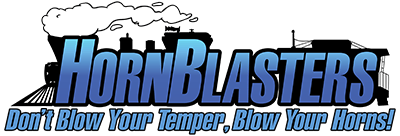COLIN PETERSON'S TAKE ON TRAIN HORNS
Below you will find our take on an article written by Diesel Tech Magazine Assistant Editor, Colin Peterson. He explains the difference between real horns vs the imitation horns as well explaining his love for the real locomotive train horns and how train horn kits have become the new standard on all trucks. Enjoy!
FIRE UP YOUR TRAIN HORNS
As Colin mentions in his article, nothing emphasizes an aggressive looking truck like a powerful train horn. After a quick search on Google you will find video after video of these extraordinary horns that will quickly put a smile on your face. Of course your typical train horn video includes someone getting scared, but that's not always the case. These systems also make for a great warning devices as well.
Chances are if you're reading this, you've seen videos of people blasting their horns to get a reaction out of someone or something. What you don't see are all the videos where train horns are being used as a safety device/precaution.
Has anyone ever pulled out in front of you? How about another driver wandering dangerously close in your lane on the highway? What about even just trying to get the attention of a driver that is dangerously distracted on their phone? At times your stock horn can get your point across but as many of us know they don't always get the job done. Now with the boost of a train horn you can make sure to get their attention no matter what the situation.
Colin goes in depth in this article explaining the differences between real horns and imitation horns. As he eloquently puts it, the real locomotive horns require pushing large volumes of air. They also require a lot of mounting real estate that is increasingly hard to find on newer vehicles. This is typically why you find these types of real locomotive horns on bigger vehicles such as lifted trucks.
HornBlasters does carry real locomotive horns; the Nathan AirChime series. The series consists of the K5, K3, P3, and P5 models each denoting a different configuration and number of “bells” (that's the fancy word for each horn trumpet). Now of course the Nathan AirChime series clearly has the throne when it comes to the loudest real locomotive sound, but the world of train horns and air horns is wide and vast.
HornBlasters manufactures a wide variety of horns that come very close to the loudness and tone of the Nathan Airchime horns. Our most popular horns are our Shocker XL model. The Shocker XL is the loudest horn you can get before going with the Nathan Airchimes. The Shocker horns produce a whopping 147.7 decibels where as the Nathans produce 149.4 decibels. What also makes these horns so remarkable is they're hand-tuned to sound just like the Nathan Airchime P5. This ensures you hear the old and authentic tone without having to worry about a huge air system and miles of installation space. These horns can run off of an air system with a tank as small as a 1-gallon and still give respectable honk times. Another cool feature of the Shocker XL horns are them being 4 individually mounted bells. This gives you the versatility of being able to mount them in any configuration you need, which is why we have seen these horns installed on anything from a golf cart to a smart car to a pickup truck.
There are some imitation horns on the market that claim to be just as good as the real locomotive horns. They are actually nowhere close when it comes to volume or tone. Typically the seller of these horns are boasting outlandish db levels that aren't even possible without causing you harm. The loudest recorded sound on earth was the Krakatoa volcanic eruption, and it was recorded at 180 db's. As you read above, real locomotive horns only register at 149.4 decibels. Any train horn claiming more than that is just making up numbers. Be sure to listen to all of the sound samples provided and look for key indications of a bogus horn.
Everyone knows that we here at HornBlasters are no stranger to loud. We take pride in the volume and sound quality of the horns that we produce and provide to the market. Even if you decide to spend a couple dollars less and go with one of the "cheaper" starter or electric horns that we sell, we know that you will still be thrilled with your purchase. The air systems included in our kits provide you with room to upgrade, giving you the ability to start with something less expensive and build it up to be the system of your dreams.
Hopefully this information will allow you to make a more informed decision when you are deciding which horns are best suited for you. Thanks for reading and catch you next time! Happy Honking!





